
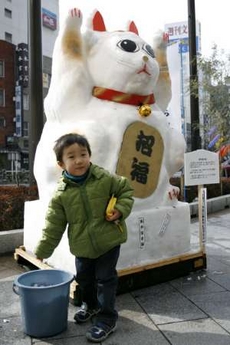
Before my Hiroshima correspondent, ironically enough, suffered an infelicity at the lens-end of a camera, I was acquainted with Maneki Neko, the white "beckoning cat" whose porcelain likeness is said to invite fortune to Japanese business establishments. The pet of a temple curate, goes the legend, saved the life of a nobleman in such a miraculous way that the lord bowed to the gods and granted, for the impoverished priest, a generous boon.
Belief in the significance of Maneki Neko pervades. It was indirectly confirmed to me that a walk through a commercial district will yield several sightings of a thickset, white feline cordially raising one or both paws. Left up, patrons are welcomed; right up, earnings and profit are embraced. When both front legs are up in the air, a request for protection is submitted. The snowman built up on a Tokyo street might have been a petition for less wintry weather, though possibly for more. This is superstition: either way the season turns, there sits Maneki Neko in the middle of timely happenstance.
My Hiroshima correspondent sent a dispatch after she was accosted by the downtown sights and sales of the annual Yebisu Festival.
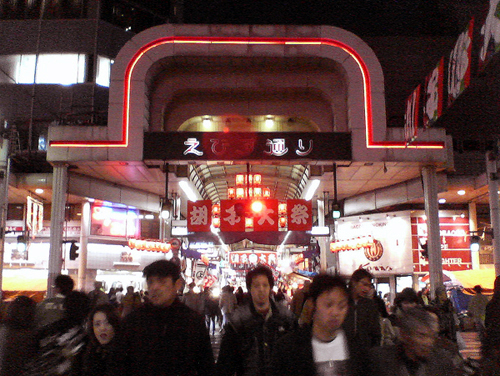
As she tells it, this photograph was taken at the intersection of Yebisu Dori and Chuo Dori the instant the crosswalk turned green.
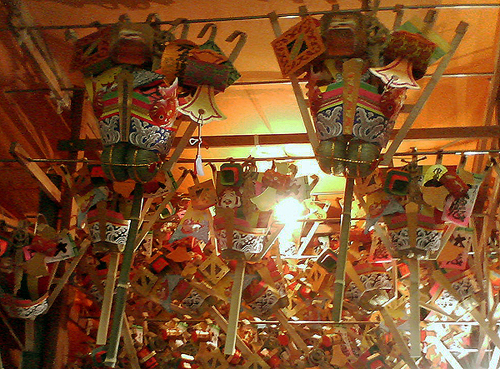
Green — economic if not chromatic — is what adorns the celebration, Yebisu being the resident god of commerce. "Trying to earn a little financial luck in the year to come," I am told, "everyone goes out and buys little ceremonial rakes." Why? "Because apparently you can't 'rake it in' if you don't have one." Craftsmen and merchants, one surmises, are among the devout.
This modest publication's cosmopolitanist feature, "Only in Japan," has lain dormant for lack of suitably peculiar slices of Japanese life — at least from the volumes of photo-journalism.
Why not freelance? Providentially, Figure Concord recently gained a Hiroshima correspondent. An American expatriate equipped with a demonstrably advanced cell phone camera and a sharp sense of amusing cultural differences, this source may provide us, over the months, an occasional look at what we all expect to see from Japan: matchless oddity. The captions are hers.
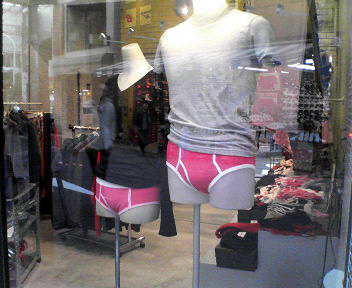
A new spin on "His & Hers."
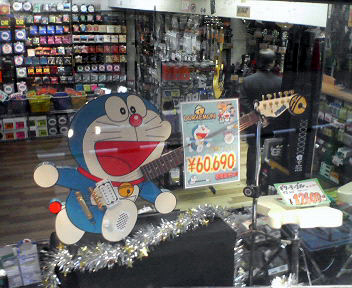
[What appears to be a Doraemon six-string] for your guitar collection.
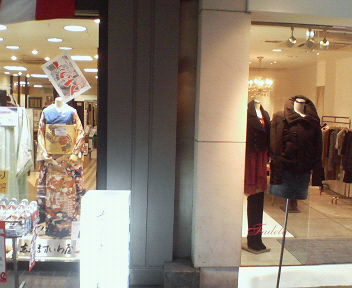
Dichotomy.
In appropriate thanks — and correct, having verified — arigatou.
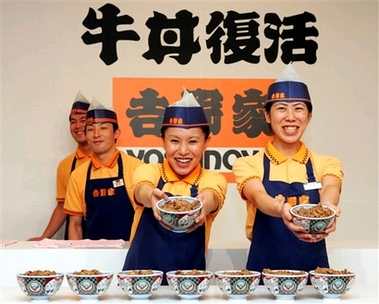
We regard the genial fast-food worker — overalls and paper garrison cap, standing between counter and kitchen, offering with both hands a meat product cooked in less time than it takes to boil water — as having become parodical tableau some twenty-five years back. With a little effort the inculcated grin can be restrained and the value of a cheap lunch or even a high school income, exclusive to liberal modernity, recognized. And then we grin.

After a two-year moratorium on account of mad cow disease, dining colossus Yoshinoya D&C Company celebrated the resumption of American beef imports with a Tokyo press conference, its beef-and-rice dish the centerpiece. Company President Shuji Abe was probably well aware of humor associated with his industry when he plucked the contents of a meal from a ceramic bowl but, looking to sales predictions showing not the slightest loss of interest from the product's suspension, had reason to smile himself.

With the 1982 theatrical release of Ridley Scott's Blade Runner came eclecticism, its strobe-and-neon frenzy of commerce and urban bustle providing science fiction writers and producers with a thematic additive, even an alternative, to the traditional utopia-dystopia dichotomy. If today, compared to yesterday's notion of the future, is a result of prophecy or contrivance we might wish to debate, for here is a sight not far removed from that which was once built by Hollywood stagehands: in Tokyo, the placid venerability of Noh theater amid downtown's skyward panoply.
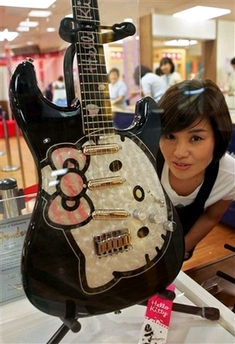
Brat-pop rockers for want of endearing, onstage commercial flair can stop looking: the Mitsui Group's chain emporium, Mitsukoshi Ltd., has set a rare Hello Kitty-stamped Fender Stratocaster out on the counter. The guitar's pickups, bridge, and volume and tone controls intrude a bit on the cartoon feline's minimalist outlines; players may also find it disconcerting, in using Hello Kitty's jaw as a pickguard, to have gradually engraved a smirk. Against this are the possibilities for fret marking raised by a nacre-white, cursive signature running down the neck.
A price tag of $21,000 will keep the instrument out of reach of all but wealthy and larcenist dilettantes. And while stars have the cash, style may be a restraint. However appropriate Kitty's bubbly insouciance might be for, say, the diminutive Angus Young and his scrubbed schoolboy uniform, it would never happen — AC/DC's lead guitarist, don't you know, only plays a Gibson SG.
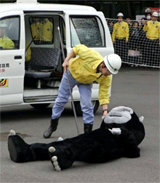
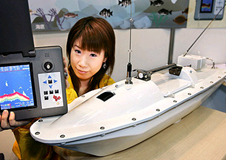
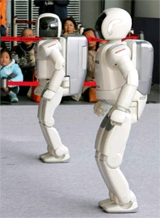
Simulation means "near verity," which can be understood as "not quite real," and in Japan that is taken as permission for artistic liberty: so an ersatz gorilla shall be drawn straight from the morphology of Nintendo. But verisimilitude is near enough, and a funny-faced fugitive ape is treated as just as dangerous — to be kept away from steel platforms, blondes and barrels.
Fishermen can cheat in a modern style as waterborne pointer Kamome tags schools like a submarine spotter. No need to fib afterwards: Kamome let it get away!
And after twelve months' gestation, the Honda Motor Company has announced its delivery of Asimo the Second — in robotic aristocracy, however, it is the penultimate son who is consigned to heir presumptive. New Asimo is faster, more dextrous; closer to the design ideal. The first astronaut-like robot stands alongside its successor in public exhibits, if only to dramatize progress in humanoid articulation by way of inferiority. Still, old Asimo — and the Second, when it too is superseded — will remain on Honda's escutcheon. Machines recede in obsolescence but are never lost, safeguarded in museums and picture books, granted the title "vintage" or "classic"; thanks to their human keepers' compassion for antiquity.

Yes, of course, a boy has only two shoulders over which peers can gape, but a crowd of young Kabuki actors backstage at the Edo-Tokyo Museum formed a dehiscent triad behind a handheld video game — showing just how bright and fluid pixels illuminate a child's face and mind. The device has no identification; the expressions require none. On our left, desire and the right, wonder. In the center, that unforgettable, inexplicable rapture of fixed captivation.
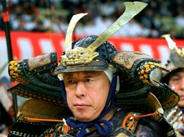
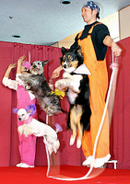
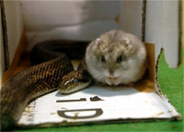
There is remembrance, rapport and conciliation in Japan. Costumiers furnished period dress in a celebration of the New Year through that which is now one hundred thirty years old; Tokyo shoppers were treated to a quartet of zoologically necessary best friends engaged in a fiduciary canter; and at the Mutsugoro Okoku Zoo in Tokyo, the wolf (in this case, a ratsnake) dwelt with the lamb (correspondingly, a dwarf hamster).
After Santa Claus' arrival in Osaka by sea, press pool photographs from Japan were stricken with a discomfiting normalcy and for weeks this series languished. With the New Year come celebrations and with celebrations, customs — and in Japan, Tokyo firefighters perched on bamboo poles, atavistic ballgames in Kyoto and kimonos on the Nikkei floor.
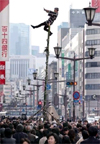
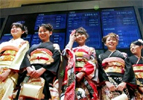
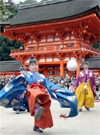
Dearest Japan, how we missed you.
